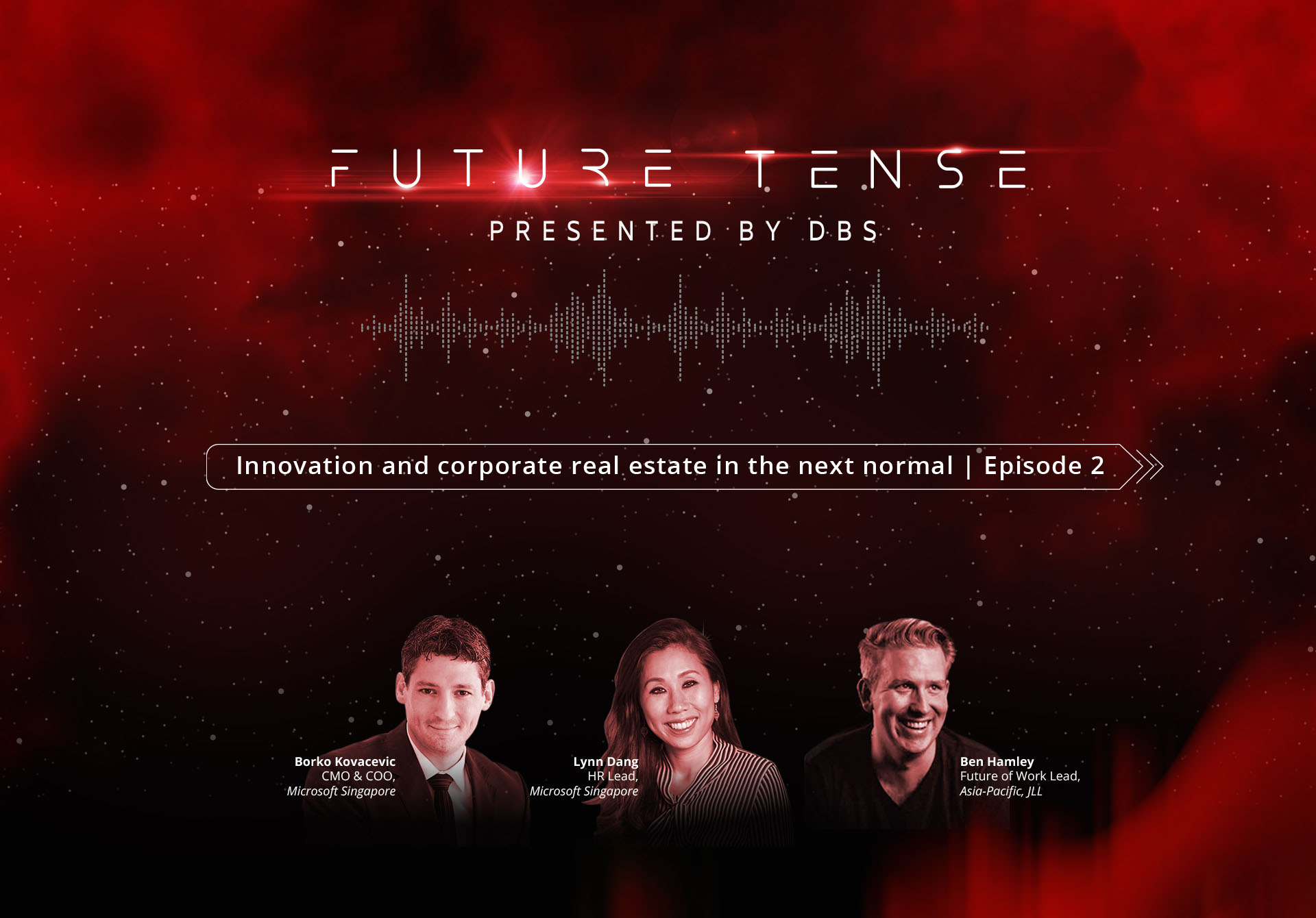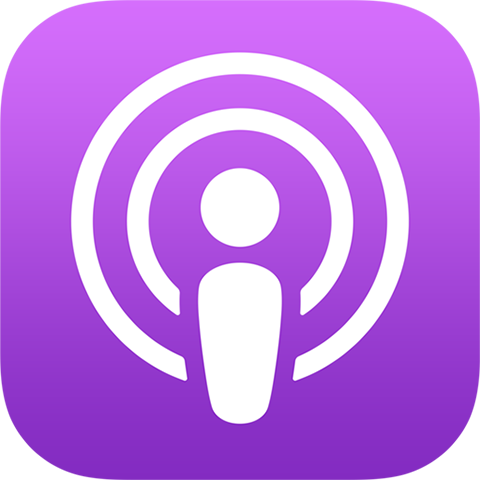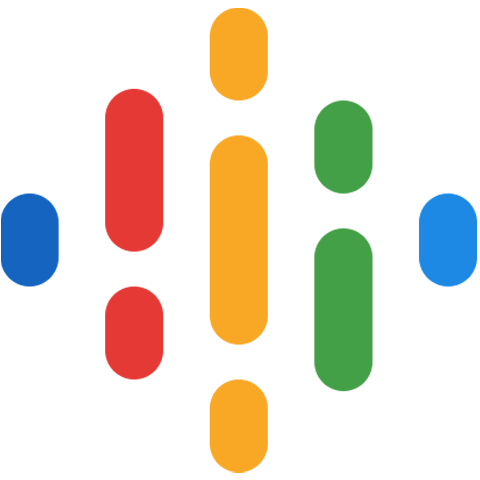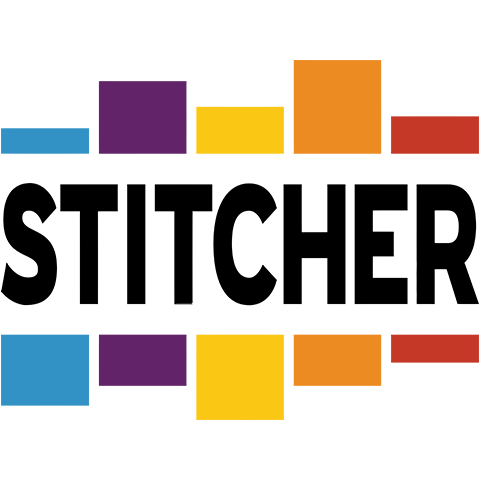Listen to this story
00:00
24:39
In brief:
-
While employees won’t be gathering in a physical space to brainstorm and co-create, innovation is likely improve with the new ways of working.
-
Present day innovation as we know it may not be as diverse as we’d think.
-
One important workplace trend – creating rich hybrid offline-online experiences to bring employees together, while apart.
-
When it comes to real estate, there is a lot more focus on sustainability, wellness and technology. For instance, democratising data to enable employees to choose how and where they work.
-
A lot is going on in PropTech. One important area will be using technology to enhance the human experience at work.
Subscribe to our podcast:
Welcome to Future Tense, by DBS. We look at what's to come for Asia and the world as technology evolves at an accelerating pace. We get you comfortable with the future as business leaders tackle big questions about sustainability, innovation, fintech and more.
In our last episode, we looked at how work would change in the future post-Covid-19. In particular, the impact of remote work on a company’s culture.
Today, we continue our exploration. When the way we work changes, will the way we innovate change too, and how?
We bring back Ben Hamley, Asia Pacific Lead for the Future of Work at JLL, with our host Carolyn Camoens.
Carolyn: Ben, when we think about catering to the individual, there is a whole slew of tools obviously, that allow people to be more productive in their role and in the way they adapt how they work. But innovation seems to be a thing that is a product of the collective. How do organisations drive innovation in the current work culture of working remotely?
Ben: It will probably improve, if I'm honest. If you've studied much innovation theory, you've probably come across the name Steve Blank and Steve Blank is famous for being involved in the early days of the lean start-up movement and codifying the approach to essentially validating the assumptions that you might have about a given innovation, in order to prove its desirability, feasibility or viability.
And that is something which in his very early lectures, he would say point blank, “you never learn anything inside the building for any innovation.” You need to get outside the building and actually go and speak to customers and go and see what's happening in the real world.
Innovation isn't something that you can do on a desktop, in an office, in a lab, in a workshop room with Post-it notes or a whiteboard or digital whiteboard or anything else. It's something that only gets done when you put your assumptions in the light of day in front of a customer and ask them if it's something they want to buy or not.
So by being more distributed, there's actually a higher chance that people are going to be in closer contact with customers or at least in closer contact with the real world.
And so perhaps are more able to take that ethnographic scientific mindset into their work, because they're not stuck in the same place every day, seeing the same thing.
Fundamentally, innovation is actually just about validating assumptions and moving through a methodical way of capturing ideas and evaluating them.
There's no reason why that can't be done distributed. There are a lot of tools that already enable you to do that and idea management or innovation management platforms already capturing that kind of data. You don't need to necessarily be in an office in order to do that anymore.
Diverse, inclusive workplaces and enabling greater innovation at a global scale
A recent study by Microsoft and IDC Asia Pacific surveyed over 3,000 business decision makers across 15 markets in Asia Pacific, within a six-month period, before and since Covid-19.
Over 7 in 10 organisations said innovation is now a “must”, for them to respond quickly to market challenges and opportunities, and ensure business resilience.
Interestingly, because many were forced to innovate and accelerate their transformation in response to the crisis – they realised that innovation was easier than they had thought.
Nearly half of organisations in the region said they found it easier to drive innovation, compared to a quarter of them before Covid-19.
Speaking with Carolyn, Microsoft Singapore’s CMO and COO, Borko Kovacevic says traditional innovation, especially in the start-up space, has never been as diverse as one might think. A more distributed workforce post-Covid-19 opens up even greater opportunity for innovation.
Here’s Carolyn, with Microsoft Singapore’s Borko Kovacevic, and Lynn Dang, HR lead at Microsoft Singapore.
Carolyn: Borko, would you say that a distributed workforce is a more democratised workforce when it comes to innovation?
Borko: For sure, I mean, more democratised as well as, shifting our thinking and our perception from the constraints that we had in the past.
And you mentioned innovation. I can probably bring up one example which is an epitome of innovation. It's Silicon Valley. I read a very good article talking about the potential impact of Covid and the post-Covid world on Silicon Valley.
If you think about how major companies have started, you have examples where these serendipitous moments have led to the creation of world's biggest companies, like Zuckerberg founding his company in a pad with a couple of friends just because he met Sean Parker in a neighbourhood. And then he introduced him to Peter Thiel, which he knew from before. Peter Thiel from PayPal met Max Levchin in a dorm, and they arranged a meetup over smoothies and they started talking about PayPal.
These serendipitous moments are leading us because of this informal human connection where we actually bond and we think about things that are possible. This is where these moments of spark come, and that's the non-formal co-creation during break time or something that happens when people get together outside of the boardroom.
When you think about the future, how do we break the boundaries of, for example, the fact that this type of innovation, especially in the start-up space, was never that diverse and was never tapping into the global talent at all?
Last year there was a study done for the last 15 years of VC fundings that went into start-ups – predominantly Silicon Valley but other hubs as well – 2.3% of funds went to African-American and Black founders, 2% to female founders. So if you're not a white male in that innovation start-up space, you're just watching the action. You're not a part of it.
When we democratised innovation and when we talk about innovation at a global scale, where we're looking at a completely different way of what the hub means, which is not one place or one neighbourhood, you're really opening up to a lot of great potential where you're tapping into global talent.
Carolyn: Thank you. Lynn, I think you had a point you wanted to make?
Lynn: Yeah. And just to elaborate a bit more on Borko's point, which I completely agree with, is that these sparks of ideas have happened in Silicon Valley. But if we actually see some of the challenges that the tech industry faces now, there's more backlash against Facebook or Uber, it’s really just that notion about diversity and inclusion.
I would say we've challenged the notion when we think about the traditional workplace, where you have meetings, where everyone is in the room and – we have been there – where there's only one or two voices that dominate the conversation and the rest tend to be muted.
There's this idea now that when we move into the future of work, one, by tapping into more skills in the workplace, we can build more diverse workplaces and two, be able to include more voices to ensure that more voices are heard so that you're not having a dominant voice.
And so I'm very optimistic about the future of work in the sense that we need to ensure that we're creating diverse work places but also this inclusive environment that we may not have seen in the past in the tech industry and certainly something we work at, at Microsoft too.
Carolyn: It's interesting, we're all back in our garages and we're all in our little bubbles, but possibly that's going to create a better environment of innovation than the breakout rooms.
I wanted to reference a quote from Mr (Satya) Nadella himself. What he said, “We’re burning social capital we've built while maintaining productivity.” Can you comment on what that means in terms of the responsibility of the organisation, in terms of building social capital and the impact that then has in creating a productive and engaged workforce? Stay with you, Lynn.
Lynn: Yes, so, to put context to Satya's quote, he was asked about working from a physical office to all remote working teams. What he was saying was that if we shifted from a full office environment, to full, remote environment for everyone, then really, it's replacing one dogma with another dogma. And that's where we're burning the social capital we've built while maintaining productivity.
Here for us at Microsoft, we've not made any statements about, every role can work anywhere. That's truly not what it's about. It's actually about a hybrid model.
Now, Covid may have accelerated some of the transformation we were already doing about providing a very fluid and flexible workplace, but we were already on that journey as well.
So there will be some roles where you can actually be fully remote – and we see this year in Asia where someone supporting the Asia region can be based in Australia, they can be based here in Singapore, they can be based in China or in India. That allows us to tap into all those markets from a talent point of view. But at the same time, there will be roles where we need physical presence onsite or people themselves crave that human connection. So having that option.
It’s really providing that flexibility to our employees and really thinking about the way we're working and making it more inclusive. When we set up a (Microsoft) Teams meeting, for example, having both the option to dial in where we can do videoconferencing, but also having the physical space for people to come in as well.
Overcoming perceived distances by creating rich hybrid offline-online experiences
Carolyn: Borko, with a lot of Microsoft's clients also needing to innovate the way that they are transforming their own workplaces to respond to these current trends, what have you been seeing Microsoft clients ask for, for example, in the workplace that maybe in the last six to 12 months have become more important?
Borko: I guess the real challenge that corporates are facing now and one that Microsoft is trying to address is, as Lynn mentioned, we've been on this journey for a while now to ensure that we enable this hybrid experience and the richness of the hybrid experience where you have teams operating remotely as well as on site.
Microsoft was operating, as well as our customers and partners, in a world that's distributed. And you'd have an expert or a subject matter expert which needs to dial in from Beijing because he’s just not able to fly. If there is a meeting that needs to happen and the person can’t be at the same time in a couple of places, the work happens remotely.
To allow that, Microsoft was coming up with different kinds of technology like our Surface Hub, which allows the ability to co-create and innovate with the digital whiteboard in a room where a number of people would be together. But then a number of other people would be in other rooms, either on a Surface Hub or using their laptop and connecting through Microsoft Teams. What we're been trying to do is effectively allow that collaboration to happen remotely in an almost seamless and effective way as you would do it in a room.
I think we are there, in a sense that the only thing that prevents us from really feeling we can co-create together, even though we are remote, is that personal feeling and habit that human beings have – in a sense that we're so used to being in a room when we do design thinking or co-creation, any kind of conversation where you need to be creative and you need to do effective brainstorming.
We are as a species, evolving at this time to make sure that we strive for better results, even though we are remote and apart.
And this will allow us to tap into global expertise and global IP, rather than being confined to one country or one region if you allow yourselves to innovate in this manner.
“The office is not going away. It's just evolving”
With technology offering new and exciting ways for people to come together to co-create – what then does this mean for real estate and the office space?
A JLL report noted that across Asia Pacific, office leasing was generally subdued during the first half of 2020, with only select markets posting quarter-on-quarter price increases. Office rental prices in Hong Kong and Singapore, for instance, reported sizable declines.
How can the workplace be reimagined to face the new realities post-pandemic?
JLL’s Ben talks about trends and technology they see emerging.
Ben: While you might have a more distributed talent pool, you might also have a more distributed network of office locations rather than all be concentrated in one space. You might have flexible workspaces available in every country, and they may actually carry the same workplace experience and workplace design as was once part of your headquarters.
The important thing is that the office itself plays a very important role in building that social capital and social connection and collaborative work and wherever that is, that will still be the case.
Carolyn: So let's talk about that for a minute. We have seen people give up office spaces, deeming them no longer workable, either in the near term with social distancing measures, people feeling like they'll be paying for double the space they can actually use, for example.
But also, people feeling like the corporate real estate investment may not be worthwhile in the long term, given the current trends.
What's JLL’s view of that?
Ben: What we're seeing is a lot more focus on the questions of sustainability, wellness and technology.
For people who have invested in the right technologies to make their workplace a really safe and healthy place to work, it's actually a very attractive proposition, regardless of how many people you can get in there.
Perhaps you're rotating shifts through, perhaps you're actually adjusting the organisational design of your company so that the office space is used for what office space is best used for – rather than just putting people behind a desk and getting to work on a document for eight hours a day, that work can be done potentially anywhere. But the creative collaborative work that enables people to foster more social capital and connect themselves with their colleagues. That stuff needs to happen in an office.
We're also seeing a lot more investment into understanding carbon emissions and the building health itself. So heating, ventilation and air conditioning systems, air filtration systems, temperature sensors.
Although social distancing is one thing and filtering out bacteria and viruses, particulates and other things like that is front of mind right now, what we've often found in places like Shanghai in some times of the year, even in Singapore with haze, is that the office is a healthier place to work.
And so it remains a very desirable part of people's overall working experience because they can't afford to finance those things on their own.
And if you push all of that out onto the workforce to carry the burden, you're actually breaking a lot of the original contract for labour that most employment contracts are built on. You have to start paying people for setting up all of those systems in their own house. If you're a bank, you need to invest in the IT security systems in every single individual's Wi-Fi router in their home. So the office is not going away. It's just evolving.
It'll take organisations really reconsidering their organisational design and their strategy, and the way they think of real estate and the workplace or, perhaps more appropriately, the places of work, as the operating system of the company.
Just like the operating system of a computer enables all the software to run effectively on that platform, the real estate in the places of work that a company has, is the platform that enables the company and its business model, and its people, capabilities and what they do, and the tools they use, to create the value that the company wants to create.
So you need to tweak that operating system. I think the traditional view of an office as a container for your stuff and for your people is a very outdated operating system.
Carolyn: What will then be the evolution of the office spaces in which they've created, for example, a dedicated whole floor to a canteen, its own gym and things like that. All of those things which have been catered for a certain number and type of workforce and a certain type of work culture. How will that evolve?
Ben: It depends on the specific attitude of the company. Everyone is going to have a different preference when it comes to what amenities are available to them. Some people are going to take a little while to trust engaging with a very high contact environment, whether that's a cafeteria or a gym, for example. Those sorts of things will probably evolve.
But I think in general, the types of spaces that you'll see people use will be very similar to the ones you have now. I don't think we're going to see a full swing back to private offices and cubicles.
However, what we probably will see is organisations equipping individuals with more tools. So right now, we typically issue you with a laptop and maybe a phone, but we might now start seeing people be equipped with their own miniature facilities management kit, miniature cleaning kit, things that enable them to make their workspace safe and hygienic wherever they are, and have the same amount of flexibility in the types of workspaces that they use, but be able to be confident and trust that those spaces are going to be cleaned in the way that they need to be cleaned.
We've already seen a huge surge in new value propositions around health and well-being. Cleaning rosters have been increased in a variety of different companies that we provide services for.
But the types of spaces, I think they'll be fairly similar. They'll probably just have a little bit more technology infused into them so that whatever room you're in, you'll be able to turn that into a virtual meeting room if you need it to be. Those sorts of ubiquitous computing solutions that actually make a building, not just a smart building, but a responsive building that can enable you, with as minimal contact as possible, detect that your device is present and then configure it to your specific preferences – adjust the lighting, change the space, whatever it might be.
You'll see probably a lot more technology put around workplace experience apps: being able to book space or being able to see how densely populated a certain part of the office is and decide for yourself whether you want to go there or go somewhere else.
Taking all of the data and information that have been in offices for so long, and in some cases have never even been monitored by the people running those offices, but democratising them and enabling every employee to choose how and where they engage with their workday, that will be the big shift you'll see.
Embedding the “human layer” into PropTech
Carolyn: What are some of the most exciting technologies that you've put into reinvented workspaces outside of the current context?
Ben: For me, it's definitely one around senses and understanding how people move through space, how much time they spend, what sort of patterns people have in terms of when they're using space.
Those kinds of behavioural insights into the way offices are used, are starting to now be something that our more sophisticated clients are doing for themselves with technology that we've installed for them – building spaces that facilitate not just a WebEx video conference, but actually an immersive digital workshop experience.
Those are things that we've experimented with in our own offices in Hong Kong and Singapore. So we have a system there, which enables you to have a workshop in Hong Kong that someone can attend in Singapore and on the same screen see the same content moving around and interacting with each other in two separate locations. Those tools are also available in a way that you can distribute them so you can access them from a device or an iPad or a laptop if you're in a car or anywhere in the world.
So we're starting to see ways of keeping people together, even when they're very apart.
From a PropTech perspective, there are a number of different innovations going on, at the building level where we're looking at not just the integrated workspace management systems, but the technologies that enable us to get better data from the building about its health, detecting faults and doing proactive maintenance and cost saving through some of that predictive analytics work.
There is a lot going on in the world of PropTech. And I think what we'll start to see now is a lot more technology being applied to the human layer – the soft layer, I guess you could call it – of how the organisation itself works and how the people within that organisation can get data for themselves to act on it.
Carolyn: From the JLL perspective, you have five pillars across which your future of work perspective is organised, essentially. Will any one of them be more important in the immediate term versus another in the longer term? How do you see these five pillars playing out?
Ben: For a long time, people thought the future of work was a technology driven narrative. Whenever you said the words “future of work”, you probably in the very same sentence said “automation”, “artificial intelligence”, “machine learning”, things like that.
Now we're starting to see the concept of the future of work shifting to a much more human story.
So human experience has always been one of the central pillars, and it will continue to be probably the most essential pillar of our point of view on the future of work, because of what we've seen as we've rapidly arrived in the future.
Technology will continue to play a part. But I think technology will play a part that we haven't quite understood yet in the same way that when we went through the Depression, prior to the roaring 20s of the 1920s, it was a very general technology like electricity that enabled economic recovery to really kickstart again.
It'll be perhaps artificial intelligence or one of those types of technologies that, applied in a much more general way, will drive the economic recovery in the twenty twenties.
Having said that, that will only be in service of creating new types of human experience.
Ultimately, the technologies that company itself might be developing, they'll all play a part. But I think it will continue to be a human experience, which is the central most pillar, in our view, on the future of work.
Carolyn: And as JLL reinvents the future of work for its clients and broadly in the industry, what's the future of work at JLL?
Ben: The thing we've realised now is that as we re-enter the workforce and in fact begin to reimagine the future of work, there are more domains that need to be considered. And we actually do need to start thinking of the future of work in a slightly different way because there isn't one future. It's actually more like a possibility space of work futures.
So we're very proactively engaged in creating a variety of different possible scenarios for what the future could be and then working backwards from that to figure out what needs to be true in order for that to happen so that we can use those weak signals as a way to navigate.
When things are incredibly uncertain, traditional planning approaches just don't work. We need different ways of being able to understand the future and talk about it so that we can figure out when things we thought could happen are happening and when things that we thought would happen definitely are not. And adapt to that in a faster way.
So less planning and more imagining, but also more constant proactive monitoring of change so that we're prepared for whatever future actually unfolds. That’s how we're thinking about it now. And that's the kind of work that we're doing.
What do you think? Is innovation taking place at a greater scale in your company? What is the new place of work you want to see?
Stay tuned as we take this discussion one step further in our next episode. We explore the evolving dynamics between employer and employee, what this means for jobs and performance measurement.
Subscribe now to our podcast Future Tense, by DBS, and keep up to date with our upcoming episodes.





